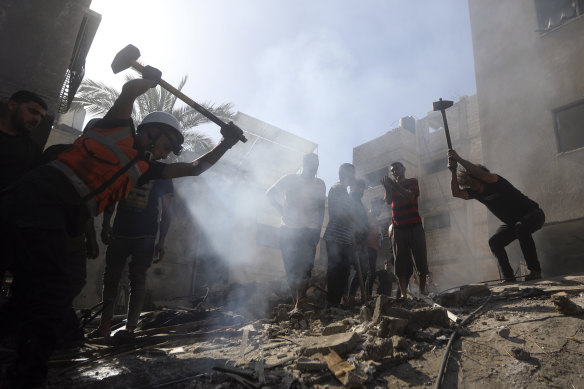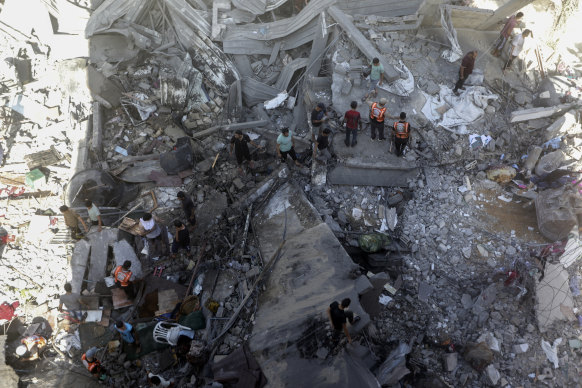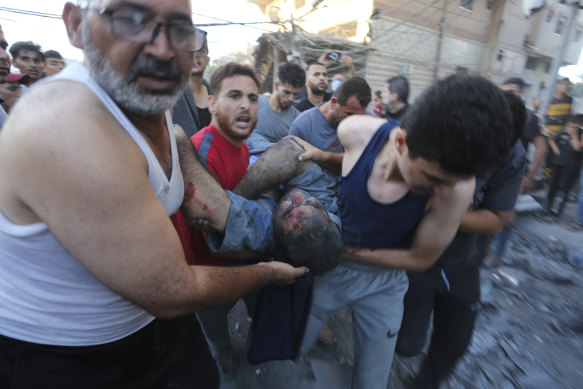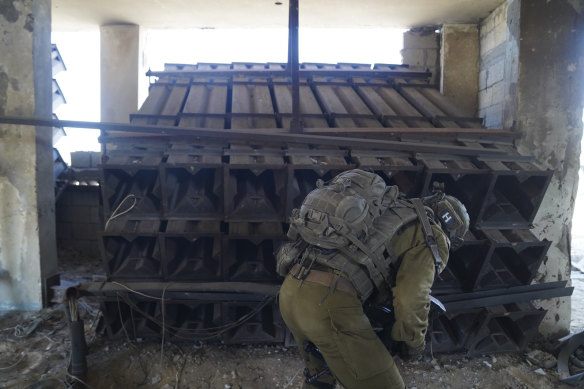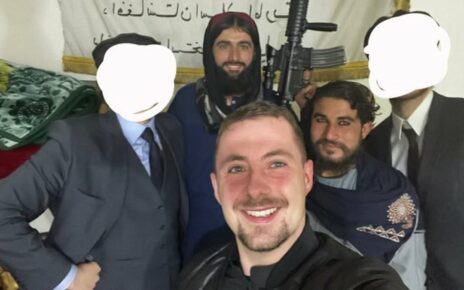Save articles for later
Add articles to your saved list and come back to them any time.
Key points
- US Secretary of State Anthony Binken says aid effort will expand significantly in coming days.
- Death toll of Palestinians tops 10,000.
- Israel says it is closing in on Hamas.
- Hezbollah and Israel report intense exchanges of fire across Israel-Lebanon border.
- Hamas says it damaged 27 Israeli military vehicles in 48 hours.
Gaza: UN agency leaders saying “enough is enough” demanded a humanitarian ceasefire on Monday nearly a month into the war in Gaza, where Palestinian health authorities said the death toll from Israeli strikes now exceeded 10,000.
Israel has rebuffed mounting international pressure for a ceasefire, saying hostages taken by Hamas militants during their rampage from Gaza into southern Israel on October 7 should be released first. Hamas says it will not free them while Gaza is under assault.
Palestinians look for survivors under the rubble of a destroyed building following an Israeli airstrike.Credit: AP
A Reuters journalist in Gaza said Israel’s overnight bombardment by air, ground and sea was one of the most intense in its offensive prompted by the October 7 attack in which Hamas killed 1400 people and seized more than 240 hostages.
The health ministry in the Hamas-controlled enclave said at least 10,022 Palestinians have since been killed, including 4104 children. International organisations have said hospitals cannot cope with the wounded and food and clean water are running out with aid deliveries nowhere near enough.
“An entire population is besieged and under attack, denied access to the essentials for survival, bombed in their homes, shelters, hospitals and places of worship. This is unacceptable,” the UN chiefs said in a joint statement.
“We need an immediate humanitarian ceasefire. It’s been 30 days. Enough is enough. This must stop now.”
The 18 signatories include the UN High Commissioner for Human Rights Volker Turk, World Health Organisation head Tedros Adhanom Ghebreyesus, and UN aid chief Martin Griffiths.
Palestinians look for survivors under the rubble of a destroyed building following an Israeli airstrike in Khan Younis refugee camp, southern Gaza Strip.Credit: AP
US Secretary of State Antony Blinken is touring the region to try to reduce the risks of the conflict escalating, get more aid into Gaza and draw up plans for a sustainable future for both Israel and the Palestinians.
Washington is seeking pauses in fighting to allow in aid rather than a ceasefire, arguing, like Israel, that Hamas militants would just take advantage.
“We are working very aggressively on getting more humanitarian assistance in Gaza,” Blinken said in Turkey. “And we have very concrete ways in doing that. And I think we’ll see in the days ahead that assistance can expand in significant ways.”
Palestinians evacuate survivors after an Israeli strike on the Gaza Strip.Credit: AP
‘Closing in’ on Hamas
The Israeli military said its forces had taken a militant compound and were poised to attack Hamas fighters hiding in underground tunnels and bunkers in the northern Gaza Strip, having isolated the area with troops and tanks. It released video of tanks moving through bombed-out streets and groups of troops moving on foot.
“Now we are going to start closing in on them,” Lieutenant-Colonel Richard Hecht told reporters.
The armed wing of Hamas, the Al-Qassam brigades, said it had damaged 27 Israeli military vehicles in 48 hours and inflicted significant losses in direct engagements with Israeli troops.
The health ministry in Gaza said dozens of people were killed by Israeli air strikes in the north and south, with eight killed in an air strike that hit Gaza City’s Rantissi cancer hospital. Israel’s military said it was looking into the report.
The International Committee of the Red Cross (ICRC) said it had escorted a four-ambulance convoy of patients from Gaza City to the Rafah border crossing with Egypt, expressing relief. Evacuations had been suspended since an Israeli strike on an ambulance on Friday.
Blinken’s visit to Turkey followed an unannounced trip to the Israeli-occupied West Bank to show support for Palestinians there and in Gaza and an earlier visit to Israel, as well as talks in neighbouring Jordan with regional Arab leaders.
Israeli soldiers check a rocket launcher used by Hamas militants in the Gaza Strip.Credit: AP
US CIA Director William Burns was also set to visit Israel on Monday to discuss the war and intelligence with officials, the New York Times reported.
Burns will also make stops in other regional states, it quoted an unnamed US official as saying.
The CIA did not respond to Reuters’ request for comment.
US Central Command, which covers the Middle East, said on X a nuclear missile submarine had arrived in the region – an unusual announcement seen by some analysts as a message to Iran, an Israeli foe.
Rockets launched
Iran said the US had sent a message saying it sought a ceasefire in Gaza, but Iran had seen only US “support of genocide”.
Both the US and Iran say Tehran was not directly involved in the October 7 attack but Iran supports Hamas as well as other Islamist militants in the region, including Hezbollah in Lebanon, which has exchanged fire with Israel repeatedly since.
Israel said on Monday it had detected about 30 rocket launches from Lebanon in an hour. Hamas said it had launched 16 missiles towards Nahariyya and Southern Haifa in Israel.
People searched for victims or survivors at the Maghazi refugee camp in Gaza, where the health ministry said Israeli forces had killed at least 47 people in strikes early on Sunday.
“All night I and the other men were trying to pick the dead from the rubble. We got children, dismembered, torn-apart flesh,” said Saeed al-Nejma, 53. Asked for comment, the Israeli military said it was gathering details.
Israel said 31 soldiers had been killed since it began expanded ground operations in Gaza on Oct. 27 and reiterated that Hamas was hiding with civilians and at hospitals. Hamas urged the UN to verify the “false narrative” that Hamas was based in hospitals.
The Israeli military said a four-hour window for civilians to leave the north would be repeated daily. UN monitoring showed fewer than 2000 people used the corridor on Sunday, citing fear and road damage. Between 350,000 and 400,000 people are still in the north, a US envoy said on Saturday.
Reuters
Get a note directly from our foreign correspondents on what’s making headlines around the world. Sign up for the weekly What in the World newsletter here.
Most Viewed in World
From our partners
Source: Read Full Article
